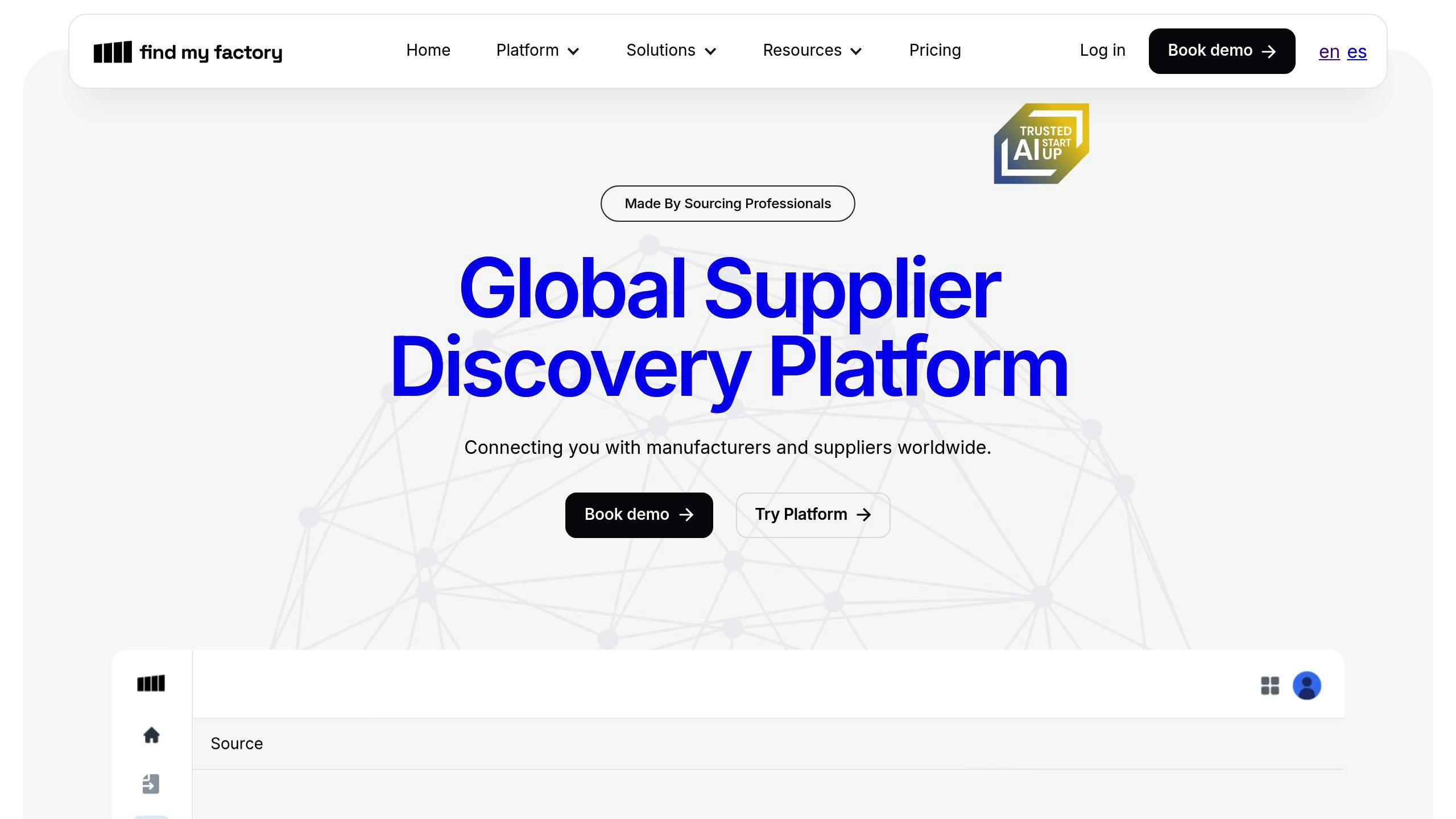Main Pages
AboutPricingSecurityCareerCustomersContactBlogFeatures
Monitor & EnrichDiscover & SourceRFI & EngageOur Socials
LinkedinLegal
Terms of UseMay 9, 2025
Explore how AI enhances lead time predictions in procurement, driving cost savings, accuracy, and smarter decision-making.
Articles

AI is transforming procurement by improving lead time predictions - helping businesses save costs, optimize inventory, and enhance production planning. Here's how AI-driven tools are changing procurement:
AI uses advanced algorithms like Random Forest, ARIMA, and LSTMs to analyze patterns and trends. With proper data preparation, model selection, and system integration, businesses can unlock these benefits while overcoming challenges like fragmented data and upfront costs.
Quick Benefits Summary:
BenefitImpactInventory OptimizationMaintains optimal stock levelsCost ReductionCuts operational and inventory costsSupplier ManagementTracks performance and mitigates risksReal-Time AdjustmentsAdapts to market and logistics changes
AI-driven lead time prediction is no longer optional - it’s a must-have for modern procurement success.
AI is transforming how companies predict lead times by analyzing large datasets with advanced algorithms.
To predict lead times effectively, AI systems pull information from various data sources. These inputs help create a detailed view of the factors influencing procurement timelines:
Data CategoryExamplesImpact on PredictionHistorical DataPurchase orders, delivery recordsEstablishes baseline trendsSupplier MetricsPerformance scores, capacity dataOffers supplier-specific insightsExternal FactorsWeather patterns, market trendsConsiders external influencesReal-time DataProduction schedules, inventory levelsSupports real-time adjustments
For example, Border States used the GAINS Halo360° platform to combine these data streams, improving lead time prediction accuracy by 31% [1].
AI systems use three main techniques to generate precise predictions:
Companies like Border States have seen real results with these methods. Their AI-driven forecasting led to a 31% boost in accuracy and $21M in inventory savings within just six months. Industry studies back this up, showing AI can improve prediction accuracy by 19-40% [2].
Migrating to the cloud allows centralized access to data, which is critical for AI processing. This approach combines data from multiple sources, creating a strong foundation for accurate lead time predictions.
"Moving to a cloud-based platform wasn't just about upgrading our technology - it opened the door for advanced AI capabilities that weren't accessible to us before" [1]
To organize data effectively, focus on these key sources:
Data TypeSourcePurposeHistorical RecordsERP SystemsIdentify baseline patternsSupplier PerformanceSupplier Management PlatformsMonitor vendor reliabilityMarket ConditionsExternal DatabasesFactor in market influencesReal-time OperationsLogistics SystemsSupport dynamic adjustments
Once data pipelines are in place, the next step is developing AI models. Border States, for example, used a dual-model approach with Administrative Lead Time (ALT) and Production Lead Time (PLT) models [1].
When selecting models, focus on those that:
Proper integration ensures smooth workflows and actionable insights.
"Having customized analytics has been a game-changer. Now we can see exactly where lead times are changing and, more importantly, what's causing those changes. That kind of visibility allows us to be proactive instead of reactive" [1]
Key components of integration include:
AI in procurement offers a mix of opportunities and hurdles that require careful planning to maximize its potential.
AI has transformed lead time prediction in procurement, offering measurable improvements. Enhanced prediction accuracy directly impacts financial performance. For example, a 31% boost in accuracy led to a $21 million reduction in inventory costs within six months [1].
"Having customized analytics has been a game-changer. Now we can see exactly where lead times are changing and, more importantly, what's causing those changes. That kind of visibility allows us to be proactive instead of reactive." - Kory Jacobson, Regional Procurement Director, Border States [1]
Despite its promise, implementing AI comes with challenges. High-quality data is essential for accurate predictions, but many companies face fragmented data systems and inconsistent formats [4].
The costs can also be steep, including expenses for infrastructure upgrades, technical expertise, and ongoing maintenance. Another issue is the lack of transparency in AI models, which can discourage adoption, especially in industries with strict compliance requirements [3].
When comparing AI to traditional approaches, the differences are clear:
AspectAITraditional MethodsAccuracy19-40% improvement in predictions [4]Limited by human analysis capacityData ProcessingHandles complex patterns and multiple variablesBasic statistical analysisReal-Time UpdatesAdapts instantly to market changesRequires manual updatesRisk ManagementIdentifies risks proactivelyReactive approachCost StructureHigher upfront cost, lower long-term expensesLower initial investment, higher ongoing costsImplementation TimeLonger setup periodFaster to implement
For AI to work effectively in procurement, two things are crucial: high-quality data and accurate models.
A global industrial machinery company saw a 39% boost in prediction accuracy by focusing on systematic data management [5]. Their approach included automated data cleansing and regular audits to ensure consistency.
To achieve similar results, prioritize:
AI can process patterns and flag risks, but human oversight is essential for applying these insights effectively.
"The key to successful AI implementation in procurement is not just about the technology, but also about people and processes. It's crucial to have a clear strategy, clean data, and a team that understands both procurement and AI." - Michael Lamoureux, Lead Analyst at Spend Matters
In practice, AI identifies trends, while humans provide context, manage relationships, and make strategic decisions.
AI’s predictive capabilities can greatly enhance supplier management by offering:
These tools allow organizations to manage suppliers more strategically, improving decision-making and reducing risks in procurement processes.
AI is reshaping procurement in ways that go far beyond initial implementations. As businesses continue their shift toward digital tools, AI-driven lead time prediction is quickly becoming a key part of procurement strategies. This shift is changing how procurement teams operate, focusing on efficiency and smarter decision-making.
Here’s what the future holds for procurement:
AI-based lead time prediction is proving to be a game-changer for procurement. Data shows it boosts both accuracy and efficiency, helping organizations streamline their operations.
The results from early adopters highlight how this technology has moved from being experimental to becoming a must-have tool in modern procurement. Its operational and financial benefits make it an essential part of the infrastructure for businesses aiming to stay competitive.

Find My Factory is a platform designed for businesses looking to streamline procurement with AI-driven tools. It uses machine learning to analyze supplier performance and logistics data, offering accurate lead time predictions.

Find My Factory leverages AI to examine historical supplier performance and delivery trends, giving procurement teams actionable insights. Here's how it works:
These features help businesses make smarter supply chain decisions, reducing uncertainty and improving efficiency.
Find My Factory connects easily with existing procurement systems using standardized APIs. This ensures smooth data sharing and allows teams to use AI-driven insights without disrupting their current workflows. By integrating this platform, businesses can make more informed decisions and stay ahead in procurement planning.
Insights & Ideas